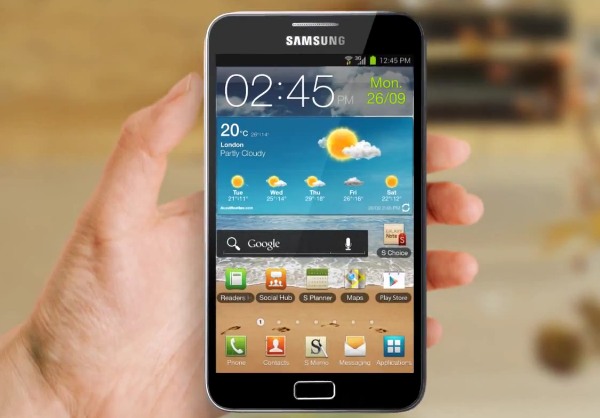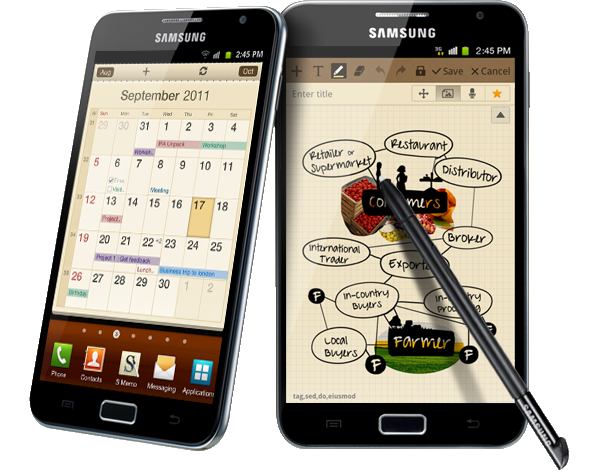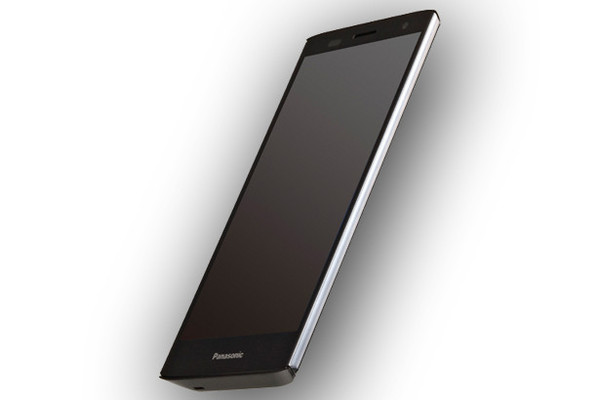Affiliate links on Android Authority may earn us a commission. Learn more.
The rise of the Phablet
Published onMay 16, 2012

Starting from the brick-style cell phone of the late Eighties, the design of the mobile has progressed towards being smaller and more feature-rich. We saw the introduction of flip-phones, slider phones, and smaller candybar style devices.
You might like: The history of the Phablet
That is, until the smartphone burst onto the scene like a crazy man in a theater, which switched and reversed the trend rapidly: faster processors, larger batteries, more storage and high-res displays have changed the way we use our phones. This allows for easier internet browsing, e-mail, video calls, and HD music and videos. While ultra-thin has become the new craze, we’ve seen a continuous increase in the screen size of mobile phone displays, giving rise to the famed “phablet.” Herein, we present a review of said devices and what purpose they serve in the rapidly growing Android market.
What is a Phablet?
A phablet, as the name suggests, is a device that combines the voice-calling capabilities of a smartphone with the larger display sizes of a tablet. Bigger than a smartphone, but not large enough to be a tablet, the screen size of a phablet falls in the 5″ to 7″ region. Another feature that defines a phablet is the presence and use of a stylus pen. The larger size and the light and thin quality of such devices eliminate the need to carry around the comparatively bulkier tablet.
Just to clear things up, the 5.3″ Samsung Galaxy Note is considered a phablet, whereas the ASUS Padfone, with a phone that docks into a tablet casing to then be used as a tablet, is not a phablet. The idea of a phablet is to be able to enjoy the best of both worlds, without needing additional devices (or device casings in the case of the Padfone).
Let’s take a look at a few such devices available in the market now, as well as some future releases that will likely keep up the phablet trend.
Available/Coming Soon

Samsung Galaxy Note
With the 5″ Dell Streak releasing in 2010 (but failing miserably), the Samsung Galaxy Note isn’t the first phablet, but is certainly the device that led to the coining of the term “phablet” and is the first such device to enjoy massive commercial success. The 5.3″ device sold over 5 million units in just 5 months, even before the eventual US release. The specifications of the Note include:
- 1.4 Ghz dual-core Exynos processor
- 1GB RAM
- 5.3″ Super AMOLED display, 800×1280 resolution
- 32GB internal storage
- 8MP rear camera, 2MP front camera
Although the Note currently features the Android 2.3 OS, the ICS update rollout for the device is picking up steam, and is slowly being available to Galaxy Note owners worldwide. The inclusion of a premium suite of apps optimized for use with the S-Pen stylus makes Galaxy Note one of the most sought after devices available. Even with the recent release of the HTCOne X and the Samsung Galaxy S3, the Galaxy Note appears unstoppable on Samsung’s quest for quick dominance in this new market niche.
LG Optimus Vu

LG hasn’t exactly been a major player in an Android smartphone world dominated by Motorola, Samsung, and HTC, but it has stepped up its game this year with impressive high-end releases like the Optimus 4X HD. LG is also attempting to become a contender in the phablet market, and provide some competition to the hugely popular Samsung Galaxy Note, with the 5″ LG Optimus Vu. The specifications of the device include:
- 1.5 Ghz dual-core processor
- 1GB RAM
- 32GB internal memory
- 768×1024 resolution
- 8MP rear camera, 1.3MP front camera
The LG Optimus Vu will release with Android 2.3 out of the box, but LG promises an eventual upgrade to ICS. Another odd feature of the LG phablet is the 4:3 display aspect ratio, which is likely to not be well-received. Strong competition for the Samsung Galaxy Note? The public will surely decide.
Panasonic Eluga Power

Panasonic has decided to throw its hat in the phablet ring with the 5″ Eluga Power. The Eluga Power, even with its much larger size, has been designed and streamlined beautifully by Panasonic, allowing it to still fit quite comfortably in the hand, and even allowing for easy one-handed typing. The specifications of this device include:
- Android 4.0
- 1.5 Ghz dual-core processor
- 1GB RAM
- 8GB internal storage
- 720×1280 resolution
Additional features including NFC support, water and dust resistance, and super-fast charging to make this phablet stand out. It might provide some serious competition to the Galaxy Note and the Optimus Vu, once it is released.
Future Devices: Rumor Roundup
So far we’ve seen some of the devices that are already available or soon to be released in the market. It is now time to jump into the world of rumors and speculation, some confirmed, while some are too good to be true, and therefore, probably aren’t.
ZTE Phablets
Chinese companies like ZTE and HUAWEI have been known for their low to mid-range Android devices, and are far more popular in their own regional market than on the world stage. Both companies are looking to grab a chunk of the world smartphone marketshare as well, with plans to ship a combined 100 million devices this year.
HUAWEI has been creating waves with the claims of its two high-end Android devices being “the world’s thinnest smartphone” and “the world’s fastest smartest phone”, respectively. It’s obviously hoping to stand strong in competing against the HTCOne X and the Samsung Galaxy S3.
In an effort to stand out from the crowd, ZTE, on the other hand, has announced its intention to release not one, but two, Samsung Galaxy Note-like phablets by the end of 2012. The Galaxy Note is a tough act to follow, and ZTE is certainly aware of that. It will be quite interesting to see what devices the company will release to compete against the Note, in its fight to be relevant on the world stage.
Google Phablet
A largely forgotten fact about Android 4.0 is its innate support for stylus input including recognizing multi-button pens, taps, tilts, distance, and pressure. This type of usage is perfect for any handwriting or art input device, which is what most phablets aim to be.
Is there a better way to showcase the stylus abilities of Android 4.0 than on a Google Nexus device itself? With the Google I/O event a little more than a month away, the speculation wave surrounding what Google might have in store for us is rising to epic proportions. There have already been suggestions that the Android 5.0 Jellybean OS may be introduced. Further speculation states that Google might launch up to 5 different Nexus devices at this event or by the end of the year. If this is indeed true, it is not unreasonable to imagine that a Nexus Phablet would be a part of this lineup.
HTC Phablet
This is a rumor that should be thrown into the “Not true” bin. But if there is even a minor chance of this being true, I already know what my next device is going to be (and I just now bought the One X).
Verizon is adding one amazing device after another to its 2012 line-up, in an attempt to cement its place as the No. 1 network carrier in the US. Apart from multiple RAZR Models(including the RAZR HD) and the Samsung Galaxy S3, the Verizon lineup might feature a Galaxy Note competitor from HTC, at least according to Jonathan Gellar, founder of bgr.com.
The HTCphablet is said to feature:
- 5″ 1080p HD display (non-pentile)
- quad-core Qualcomm Krait CPU
- Adreno 320 GPU
- HTC Sense 5
- Scribe Pen
Wow! 1080p display? quad-core Krait CPU? HTCSENSE 5?
Conclusion
New releases such as the HTCOne X and the Samsung Galaxy S3 are pushing the lower limit of the “phablet,” but in my experience (with the One X), while big, they still handle exactly like a phone. This was not entirely the case when I was using a Galaxy Note, which had a distinct tablet-like feel. So designating a “phablet” has more to do with just size, and it looks like this type of device might be the answer for a lot of consumers on-the-go. There have been some complaints about how the Galaxy Note is quite difficult to hold, and awkward to hold up to your ear when making a call, but we’ve already seen its huge success, and with a slate of such devices set to arrive in the market, the phablet is most likely here to stay.
The phablet is on the rise, and if this does eventually become the mainstay device, I have just one simple request to make: Can someone please coin a new term to replace “phablet?”
What are your thoughts? Are phablets here to stay or just a passing phase? How good does the HTCphablet sound? Do you want to take a shot at renaming “phablet?” Let us know in the comments section below!